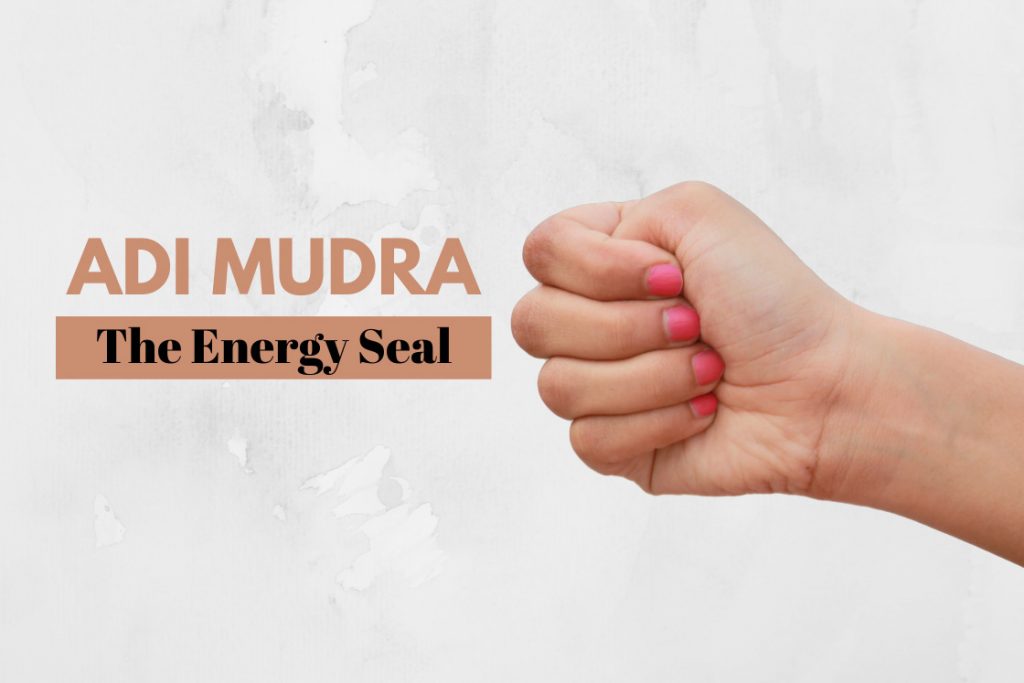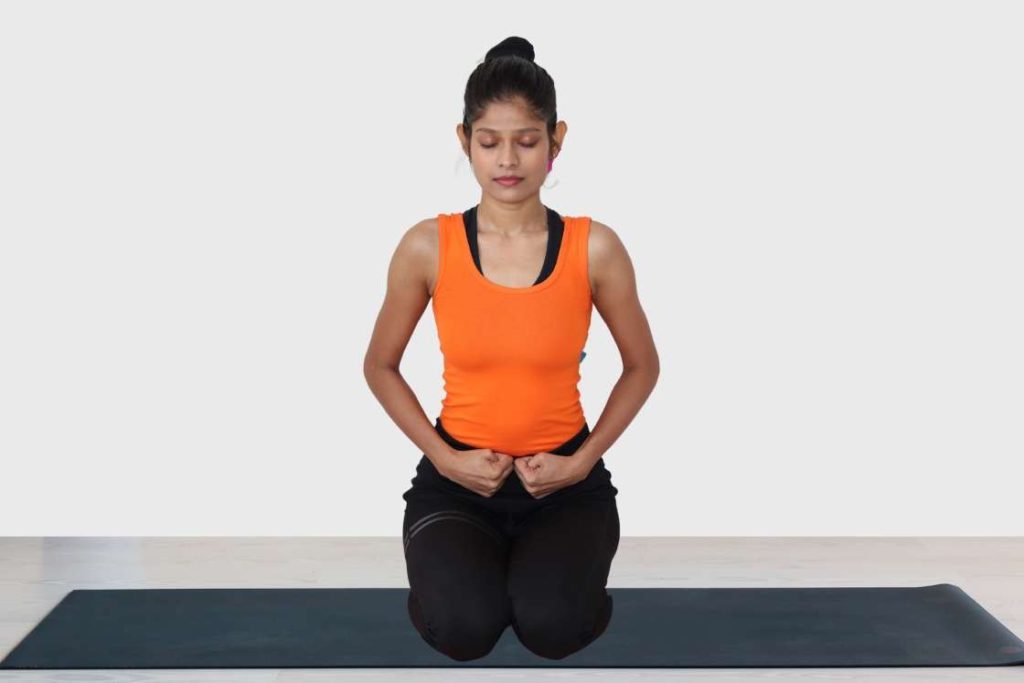- Meaning
- Steps
- Time duration
- Yoga Postures
- Adi Mudra Benefits
- Breathing exercise
- Effect on chakra
- Precautions

Adi mudra is a yoga hand gesture that looks like a fist where the thumb is tucked into the palm.
This Mudra is a great companion to meditative practices as it promotes calmness and stability of mind. You can practice it separately in your yoga session or combine it with your asana-pranayama session.
Adi mudra has a constructive effect on the breathing pattern and chest physiology which makes it appropriate to use in pranayama. Whilst performing it with meditative asanas provides nervous system benefits such as improved blood circulation, brain function, digestion, etc.
Adi Mudra Meaning
Before our hands could make any shape, it makes one simple and primal gesture, the fist. You must have seen newborn baby hands with this gesture. It’s Adi mudra – the first gesture. This is also known as Primordial Mudra and The babies gesture.
The Sanskrit term “Adi” means the first and “mudra” means a seal or gesture. Adi mudra gets its name by the hand position of a fetus inside the mother’s womb. It’s called so because this mudra is the first-hand gesture we as humans are capable of making after birth.
How to Do Adi Mudra?

To perform Adi Mudra in yoga, sit in a comfortable meditative posture; with spine erect and eyes closed. If a sitting posture is uncomfortable to you, then stand straight in mountain pose.
- If you are sitting, keep your arms on your thighs or knees with palms facing down. In a standing position, extend your arms slightly outward to maintain little distance between your hand and thighs.
- Now press your thumb against your palm, and touch the base of your little finger joint on the palm with the tip of your thumb, in both hands.
- Then join your other fingers (closing the gap between them) and clench them inward to wrap around the thumb, forming a fist.
- Maintain slight pressure in your fist, evenly across the palm, and in all fingers. However, do not press too hard, hurting your thumb.
- Obviously, you will be performing the mudra in both hands simultaneously.
After finishing up your practice, gently release your fingers and bring your palms in ease. Now rub both hands together for a while and gently touch the palms over your face (mainly the eye region).
Note: Adi Mudra’s hands can be put in different positions while in yoga practice. Palms facing down is generally recommended when you want to calm down your mind. While in other cases, palms upwards energize your body and mind.
Time and Duration
Like most of the yoga mudras [efn_note] mudra time duration https://www.ncbi.nlm.nih.gov/pmc/articles/PMC5934951/ [/efn_note], adi mudra has recommended duration of about 45 minutes a day. You can practice 45 minutes at a stretch (which is not advisable as a beginner) or you can break it up as per your convenience. The idea of instruction is to do three sets of 15 minutes each, throughout the day.
As far as “when to do adi mudra” is concerned, practicing this mudra in the morning is the best idea. You and your body will like to start your day with this mudra, as it will prep you up for the rest of the day with a lot of energy. The other perfect timing for this mudra is before going to bed. The nervous, digestive, and oxygenation benefits will trigger a sound sleep and efficient mind-body rest.
However, adi mudra can also be practiced as a quick fix in certain situations, such as immediately before activities or tasks that require high intellectual and cognitive abilities. Activities like studying, performing, examinations, problem-solving, analyzing, and such. Moreover, it can be treat as a natural holistic anti-depressant and practiced in stressful situations to calm down.
Alternative Yoga Postures
Adi Mudra can be performed in four different yoga postures; Sukhasana, Vajrasana, Padmasana or standing tadasana position. However, one can also try adi mudra in standing postures like tree pose to get a sense of balance.
Generally, different poses are chosen by people according to their convenience and comfort. People with difficulty folding their knees or sitting on the floor in general (mostly due to obesity or musculoskeletal issue,) find it easier to stand in Tadasana and practice the mudra. On the other hand for some people, who wish to hold the mudra for a very long duration, find it easier to sit in Sukhasana.
If either of standing and sitting posture is an issue of difficulty, you can still practice this mudra casually sitting (with spine erect and looking front) on a chair. Although, theoretically yogic practices do not encourage casual sitting during mudra practice.
Adi Mudra Benefits

Although adi mudra slightly differs from the regular fist, it still retains the iconic benefits of a fist.
Adi Mudra benefits your nervous system and enhances the logical ability of your brain. Holding this mudra with breathing exercise increases lung capacity, oxygen intake and strengthens respiratory muscles.
The fist in adi mudra may also sharpen the intellect and improve your motor skills. However, this mudra can benefit multiple organs in your body, that are integrally dependent on the well-being of the nerves. Such benefits include:
- A well-controlled musculoskeletal system.
- An effective movement in abdominal organs like the stomach, liver, and intestines.
- Appropriate relaxation and contraction of the respiratory passages and lung airways.
- Relaxed and resistant free blood vessels.
- An appropriate cardiac pulse.
- Stimulation to endocrine glands for healthy hormonal secretion.
Researchers believe that clenching a fist can activate specific brain regions [efn_note] Clenching fists can improve memory https://www.bbc.com/news/health- [/efn_note]. It’s shown in a study that clenching the right hand just before learning can improve memory formation, whereas clenching the left hand just before recalling can enhance memory recollection. This is a good time to mention, that your left and right hands have pressure points that express contrasting sides of the same function. As you would see in the case of memory, your right hand has memory formation stimulating pressure points, and your left hand has memory recollection stimulating pressure points.
Preparatory breathing exercises
Adi mudra puts special emphasis on benefiting your respiratory system. Therefore before the mudra starts showing its magic, it is recommended to perform some breathing exercises.
This will stimulate the nerves in advance, and prepare them to receive the maximum benefit when practicing the Adi mudra.
- Slow and deep breathing: Inhale slowly to your maximum capacity, and exhale slowly emptying your lungs. Repeat the process for a minute or two.
- 2-1 breathing: Inhale and exhale, but with the exhalation duration being twice as much as the inhalation duration.
- Box breathing: In this breathing pattern you exhale for 4 counts, hold the breath for 4 counts, then inhale for 4 counts, hold the breath for 4 counts, and continue repeating the pattern.
- 4-7-8 breathing: Exhale through your mouth to empty your lungs. Inhale slowly only through your nostrils for four counts. Hold the breath for seven counts and then exhale slowly only through your mouth for eight counts.
Effect on chakra and elements
Adi mudra unites the energy of all 5 elements present in our body, which eventually stimulates the crown chakra (Sahasrara). Crown chakra lifts and inspires you, gives mental clarity, and connects you to the divine.
The major difference between Adi Mudra and normal fist is that in Adi Mudra the thumb is inside the fist. One might say that the fist is formed such that it seems built around the thumb. In terms of elemental reference, the thumb represents the fire element. And the fire element is associated with vitality, digestion, inner strength, integrity, will power, self-confidence and courage.
In Adi Mudra the thumb being in middle, all the other elements come together and merge with the fire element. Meaning the benefits generated by activating the other four elements, work together in benefiting and protecting your vitality, digestion, inner strength, integrity, willpower, self-confidence, and courage.
Precautions and contradictions
To get the best results from Adi mudra, you need to take some precautions.
- Do not press the fingers too hard. This will end up making blockage in the nerve ending.
- This mudra is all about concentration. Perform it in a quiet and silent place.
- Wear comfortable clothes. Very loose or tight clothes can make you uncomfortable.
- Avoid distractions such as mobile during the whole session.
Considering how the fetus itself comes to this world with its hands closed in Adi mudra, it is safe to assume that this mudra is the most natural and primal hand gesture. Theoretically, this mudra has almost no significant negative interactions or contradictions.





i suffer from high blood pressure and fatigue and arthritis can you suggest what i can do for these conditions
dear ashish
Namste j
I’m 81 yrs old
I have high platelet in my blood so do u have any mudra I can do it for this problem
I will be waiting for your answer
Thank you
My name is Rumored a Purani
I am living in USA
Namaste
For high platelet levels, you might find the Prana Mudra beneficial.
Please note that Mudras can be therapeutic, but they are not a substitute for professional medical treatment. Please consult with your healthcare provider before starting any new practice.
Dear sir I am suffering from Anxiety syndrome and Asthma breathing problem unable to walk properly while walking breathlessness will be there can you kindly suggest me some remedy I am 83 years old
Sir if you’re looking for a yogic remedy, I’ll suggest you do yoga breathing exercises – Nadi shodhan and Ujjayi pranayama. You can check more exercises in this article. Apart from that, there is a mudra called “Asthma Mudra” – it will help you cope with Asthma symptoms.
Dear Sir,
IN SIDE EFFECTS, IT IS STATED THAT PEOPLE WITH HIGH BP SHOULD AVOID
ADI MUDRA. OK
IN COMMENTS WHEN A PERSON ASKED ABOUT THIS,
REPLY WAS OTHERWISE, STATING THAT THE PRACTICE OF ADI MUDRA
WILL NOT CREATE HIGH BP.
IT IS VERY “CONTRADICTING”
KINDLY ENLIGHTEN US PLEASE
Can you please mention that comment, on which page it’s?